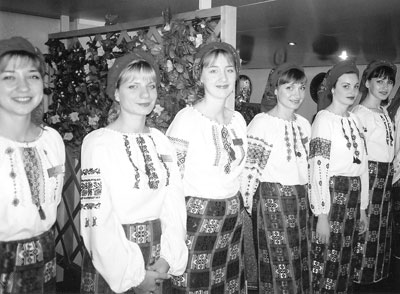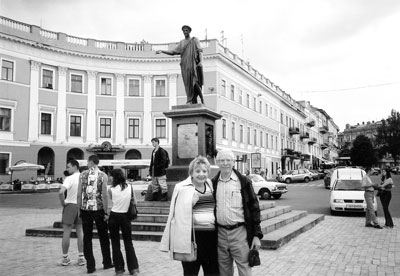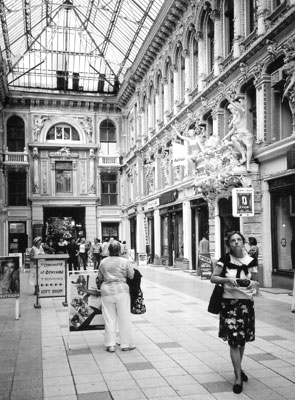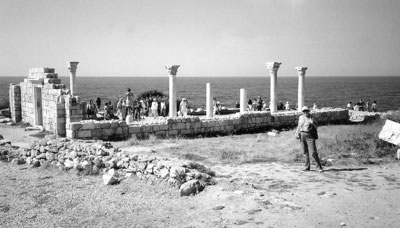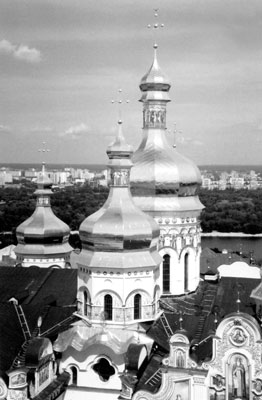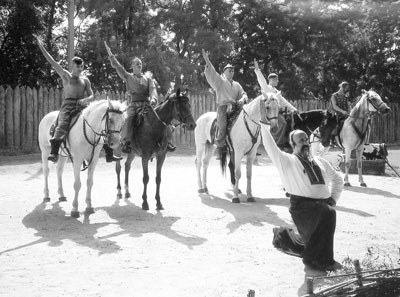Ukraine — in the wake of Catherine the Great
by Gloria Grant, Chevy Chase, MD
As a docent at Washington, D.C.’s, Hillwood Museum, featuring fabulous Russian treasures, I have been fascinated with a trip Catherine the Great made down the Dnieper River in 1787. Accompanied by the Austrian emperor and other diplomatic guests, she led a tour of her expanding empire from Kiev to the Crimea, sailing in a fleet of 80 red-and-gold Roman-style galleys, each with its own orchestra.
So when I learned of a tour in Catherine’s wake, together with visits to the homeland of the dashing Cossacks, historic cities closed to visitors during Stalin’s repressive regime and such military landmarks as the site of the Charge of the Light Brigade, I persuaded my husband to accompany me to Ukraine.
Kiev city tour
On Sunday, July 11, 2004, we joined two friends and 150 others in Kiev, Ukraine, for a 2-week cruise along the Dnieper River and Crimean coast aboard Viking River Cruises’ General Lavrinenkov. Before sailing later the next day, we took a coach tour of Kiev, one of the oldest cities in Northern Europe. Pastel-painted neo-classical buildings mingle with highrise brick and concrete structures. Trees line most streets, and wide boulevards link parks and squares. A panoramic view from the old section reveals the new city, dominated by skyscraper apartment buildings.
We stopped at Kiev Pechersk Lavra, a monastery complex of churches and historic buildings, to explore a portion of its underground caves. As there is no illumination, we purchased candles to light our way down treacherous steps, a difficult maneuver even with a handrail. We were so intent on keeping our footing and the candles lit that we failed to see the coffins set in wall niches.
As we departed Kiev, the shoreline revealed many “MacMansion” dachas, both finished and under construction.
On toward Odessa
Our first cruise stop, Dneprope-trovsk, was a Stalinist-era industrialized city. Here Catherine II laid the cornerstone of the Cathedral of the Transfiguration when she visited the area in 1787. It later fell into disrepair but has been restored to golden glory. A nearby neo-classical palace built for Potemkin, Catherine’s shrewd advisor and foreign minister, is now used as a meeting place for university students.
The next day we docked at Novaya Kakhovka, a new city created for employees of a nearby hydroelectric dam. A 15-minute walk led to a theater to see a beguiling children’s dance school performance. Dazzling costumes added to our enjoyment of this talented troupe.
The same German-made coaches we used in Kiev met us for the city tour the next day in Odessa. At the Unknown Soldier Monument, uniformed teenage girls, many in high heels, stood guard for 15-minute stints.
A free afternoon afforded us an opportunity to explore Odessa on our own, terminating in a descent along the famous Potemkin Steps leading back to the Lavrinenkov. Three optional tours were available that day: a visit to the art museum ($16), a French winery visit ($30) and a performance of “La Traviata” ($34).
Black Sea sites
The following day we departed Odessa at 8 a.m. for a coach ride to Bessarabia ($65). Though the trip afforded detailed glimpses of lush farmlands, it was far from exhilarating. Stops included a local farmstead and nearby country church plus the fortress of Akkerman at Belgorod-Dnestrovsky, an outstanding monument of medieval defense architecture. A hearty lunch at a riverside restaurant was included in the tour.
Sightseeing in Sevastopol the next day included a tour of Malakhov Hill, site of a crucial battle in the Crimean War, with views of the harbor scarred with remnants of World War II ships.
We took another optional tour for $22 to Khersones, a rocky Black Sea beach area adjacent to the former Russia’s only Greek ruins. Early Christians had rearranged ancient columns to build their churches, so no Greek temples survive, but the crumbling foundations of several other buildings remain as well as a partially restored amphitheater.
Nearby, a gorgeous new Byzantine-style church marks the spot where St. Vladimir was baptized more than 1,000 years ago, after which he decreed the country’s adoption of Christianity. Magnificent geometric designs fashioned in marble decorate the walls and floor.
Later that evening we walked from the ship to a concert given by the Black Sea Fleet Band & Dance Company, a spirited and professional performance of song and dance, optional at $35. We highly recommend this show, as grace and athleticism are exceptional talents of Russian dancers.
Yalta
Monday, July 19, we departed by coach to Yalta. Beautiful views of the Black Sea, much like those of the Amalfi Drive in Italy (without the dense development), could be seen from the hairpin-turn-filled road. Along the way to our ultimate destination, Yalta’s Livadia Palace, we viewed from afar Gorbachev’s dacha and a fairy-tale castle, the Swallow’s Nest, built by a German industrialist.
Livadia was packed with visitors, so our harried and hurried tour was somewhat disappointing. However, because it was the site of the famous meeting of Roosevelt, Churchill and Stalin in 1945, when Europe was carved up by the Allies, and because the last three Russian czars used the palace for their Crimean holidays, we felt it was a “must see” — even at $75, including lunch at a nearby hotel.
Few furnishings survive at the palace, but the round table at which the Big Three assembled remains. The Yalta promenade, replete with scantily clad young ladies, is a pleasant strolling area above its rocky, untidy beach.
Dramatic sights
We were off to the 16th-century Kahn’s palace in Bakhchisarai, built by the Tatars, the next day.
It is one of three surviving sites of similar style, the others being the Alhambra in Granada and Topkapi in Istanbul.
Our guide there was a young scholar whose tales of former occupants mesmerized us as we took in the exquisitely carved doorways, the famous Fountain of Tears and the harem quarters’ enchanting decorations with intricate walnut screens, lush rugs draping divans, brass tables and stained-glass windows.
Not far away we stopped at a huge panorama of the Battle of Sevastopol ($25 tour). An entire circular building is devoted to a realistic 3-dimensional foreground backed by a canvas depicting the battle.
Then it was on to Balaclava, whose harbor once housed Russian nuclear subs hidden in mountain tunnels with room for a whole city to service the fleet. Ukraine has plans to make Balaclava a resort area.
Lastly, we visited the battlefield where the famous Charge of the Light Brigade took place during the Crimean War. There, Lord Cardigan, lacking accurate information, led his troop into Russian cannon fire. Vineyards mark the placid landscape now.
Ukrainian traditions
On the return trip we paused at Zaporozhye to visit a museum devoted to the legendary Cossacks, originally bands of runaway serfs. The collection traces the area’s history from the Stone Age.
At nearby Khortitsa we saw a Cossacks show, a rip-roaring, fast-paced performance of trick riding, whiplash skills and dancing.
Since Ukrainian currency, the hryvna (pronounced “grievna” and worth approximately 20 American cents), is not traded on the open market, we were unable to obtain any local currency until our arrival in Kiev. However, the American dollar is generally usable on the street and aboard ship and occasionally is accepted in shops. Currency exchange locations are plentiful.
Traditional Ukrainian crafts — embroideries, weavings, carved wooden jewelry and kitchen tools, hand-painted eggs, matryoshka dolls, lacquer boxes, luxurious fur hats, silk scarves and paintings — abound at street markets and could be found wherever the boat docked.
The ship
Cabins on the Lavrinenkov, each a tiny 90 square feet, are efficiently laid out. Occasionally the air-conditioning malfunctioned, but rarely was the outside temperature so hot that we were uncomfortable. Smoking was permitted only in limited areas and not in the dining room.
Viking River Cruises (21820 Burbank Blvd., Woodland Hills, CA 91367; phone 877/668-4546) assures passengers of diversion with a lottery; a competitive quiz; lectures on history, politics and food; tours of the bridge and galley, and classical piano performances. The ship’s 7-piece band plays nearly every evening. Sun worshipers can bake on deck; readers may borrow from a limited library.
Prices for alcoholic drinks are very reasonable: $2 for beer and $2-$3 for a glass of wine. Self-service tea and coffee are available throughout the day.
Passengers enjoy open seating at the breakfast buffet and assigned tables for the other two meals. A Swiss chef offered (mostly) excellent food, beautifully presented. We sampled traditional Russian and Ukrainian dishes: borscht, chicken Kiev, beef Stroganoff, shaslik and some exciting soups and desserts. Salads were bountiful and imaginative, particularly at lunch.
Themed dinners with the staff appropriately costumed livened up the scene. One afternoon we enjoyed an optional party at which beluga caviar and champagne were served ($30).
We cannot give enough praise to our principal guide, Alla, whose expertise, language skills, patience and professional demeanor are among the best we have encountered in 40 years of travel.
Our cost for the entire trip totaled $3,500 per person, including air travel from Washington, D.C. (excluding the optional tours, as noted).


